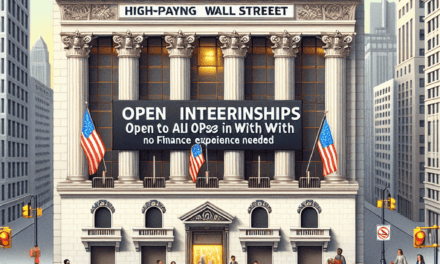“Buffett’s Bold Bet: Defying Wall Street by Ditching AI’s Crown Jewel”
Introduction
In a surprising turn of events that has captured the attention of investors and analysts alike, Warren Buffett, the legendary investor and CEO of Berkshire Hathaway, has made headlines by divesting from a leading artificial intelligence (AI) stock, even as Wall Street continues to embrace the burgeoning sector. Known for his long-term investment strategy and cautious approach, Buffett’s decision to sell off shares in a top AI company has raised eyebrows and sparked discussions about the future trajectory of AI investments. This unexpected move comes at a time when AI technology is increasingly seen as a cornerstone of future innovation and economic growth, making Buffett’s decision all the more intriguing to market watchers and financial experts. As the world grapples with the implications of AI advancements, Buffett’s actions may signal a shift in investment strategies or a reevaluation of the risks associated with the rapidly evolving tech landscape.
Understanding Warren Buffett’s Investment Philosophy: Why He Sold a Top AI Stock
Warren Buffett, the legendary investor and CEO of Berkshire Hathaway, has long been revered for his astute investment decisions and his ability to navigate the complexities of the financial markets. His recent decision to sell a top artificial intelligence (AI) stock, while Wall Street continues to hold on, has raised eyebrows and sparked discussions among investors and analysts alike. To understand this surprising move, it is essential to delve into Buffett’s investment philosophy, which has consistently emphasized value investing, long-term growth, and a deep understanding of the businesses in which he invests.
Buffett’s investment strategy is rooted in the principles of value investing, a methodology popularized by his mentor, Benjamin Graham. This approach involves identifying undervalued companies with strong fundamentals and holding them for the long term. Buffett has often stated that he prefers to invest in businesses with a durable competitive advantage, or “economic moat,” which can protect them from competitors and ensure sustained profitability. In this context, his decision to sell a leading AI stock may seem counterintuitive, given the sector’s rapid growth and transformative potential. However, a closer examination reveals that Buffett’s move aligns with his cautious and disciplined investment approach.
One possible explanation for Buffett’s decision is the valuation of the AI stock in question. The AI sector has experienced a surge in investor interest, leading to soaring valuations that may not be justified by the underlying fundamentals. Buffett has always been wary of overpaying for growth, and he may have concluded that the stock’s price had become detached from its intrinsic value. By selling the stock, Buffett could be adhering to his principle of not getting swept up in market exuberance, thereby avoiding the risk of a potential correction.
Moreover, Buffett’s investment philosophy emphasizes a deep understanding of the businesses he invests in. While AI is undoubtedly a revolutionary technology with vast potential, it is also a complex and rapidly evolving field. Buffett has historically shied away from investing in industries he does not fully understand, preferring instead to focus on sectors where he has a clear grasp of the competitive dynamics and long-term prospects. It is possible that Buffett’s decision to sell the AI stock reflects a recognition of the challenges in predicting the future trajectory of AI companies, as well as the intense competition and regulatory scrutiny that the sector faces.
Additionally, Buffett’s move could be seen as a strategic reallocation of capital. Berkshire Hathaway’s investment portfolio is vast and diverse, and Buffett is known for his ability to identify opportunities across different sectors. By selling the AI stock, he may be freeing up capital to invest in other areas where he sees greater potential for value creation. This aligns with his pragmatic approach to portfolio management, which involves continuously assessing and adjusting his holdings to optimize returns.
In conclusion, Warren Buffett’s decision to sell a top AI stock, while Wall Street holds on, is a testament to his disciplined investment philosophy. By focusing on valuation, understanding, and strategic capital allocation, Buffett continues to demonstrate his commitment to long-term value creation. While the AI sector remains an exciting frontier, Buffett’s move serves as a reminder of the importance of adhering to fundamental investment principles, even in the face of market trends and technological advancements. As investors seek to navigate the complexities of the modern financial landscape, Buffett’s actions offer valuable insights into the art of prudent investing.
The Impact of Warren Buffett’s Decision on the AI Market
Warren Buffett, the legendary investor known for his long-term value investing strategy, has recently made headlines with a surprising decision to sell a significant portion of his holdings in a leading artificial intelligence (AI) stock. This move has caught the attention of Wall Street, where many investors continue to hold onto AI stocks, betting on the sector’s promising future. As the market digests this unexpected development, it is crucial to explore the potential impact of Buffett’s decision on the AI market and the broader investment landscape.
To begin with, Warren Buffett’s investment philosophy has always been rooted in the principles of value investing, focusing on companies with strong fundamentals, competitive advantages, and attractive valuations. His decision to divest from a top AI stock, therefore, raises questions about the current valuation levels within the AI sector. It suggests that Buffett may perceive the stock as overvalued, or perhaps he has identified better opportunities elsewhere. This move could prompt other investors to reassess their positions in AI stocks, potentially leading to a reevaluation of the sector’s valuation metrics.
Moreover, Buffett’s decision comes at a time when AI technology is rapidly transforming various industries, from healthcare to finance, and is widely regarded as a key driver of future economic growth. The enthusiasm surrounding AI has led to a surge in investment, with many companies experiencing significant stock price appreciation. However, Buffett’s action serves as a reminder that even in high-growth sectors, prudent investors must remain vigilant about valuations and the sustainability of growth projections. This could lead to a more cautious approach among investors, who may now scrutinize AI companies more closely, focusing on their ability to generate sustainable profits rather than merely riding the wave of technological hype.
In addition, Buffett’s move may also influence the behavior of institutional investors, who often look to him as a bellwether for market trends. If institutional investors begin to follow Buffett’s lead, it could result in a shift in capital flows within the AI sector. This potential reallocation of resources might impact smaller AI companies that rely heavily on investor funding to fuel their growth and innovation. Consequently, these companies may face increased pressure to demonstrate their value proposition and financial viability to attract and retain investment.
Furthermore, the broader market may interpret Buffett’s decision as a signal of caution, prompting a reassessment of risk across various sectors. As investors weigh the implications of Buffett’s move, they may become more discerning in their investment choices, prioritizing companies with robust business models and clear paths to profitability. This shift in investor sentiment could lead to a more balanced market environment, where speculative investments are tempered by a renewed focus on fundamentals.
In conclusion, Warren Buffett’s surprising decision to sell a top AI stock while Wall Street holds on has the potential to significantly impact the AI market and the broader investment landscape. By prompting a reevaluation of valuations, influencing institutional investor behavior, and encouraging a more cautious approach to risk, Buffett’s move underscores the importance of maintaining a disciplined investment strategy, even in sectors characterized by rapid technological advancement. As the market continues to evolve, investors would do well to heed Buffett’s example, balancing optimism with prudence to navigate the complexities of the ever-changing financial landscape.
Analyzing Wall Street’s Reaction to Buffett’s Surprising Move
Warren Buffett, the legendary investor known for his long-term investment strategies and value-driven approach, recently made headlines with a surprising decision to sell a significant portion of his holdings in a leading artificial intelligence (AI) stock. This move has left Wall Street analysts and investors alike pondering the rationale behind such a decision, especially at a time when AI is considered one of the most promising sectors for future growth. As the financial world grapples with this unexpected development, it is essential to analyze Wall Street’s reaction and understand the potential implications for the broader market.
To begin with, Warren Buffett’s investment philosophy has always been rooted in the principles of value investing, focusing on companies with strong fundamentals, competitive advantages, and long-term growth potential. His decision to divest from a top AI stock, therefore, raises questions about whether he perceives a shift in the company’s intrinsic value or if broader market conditions have influenced his choice. While Buffett has not publicly disclosed the specific reasons for his sale, it is worth considering that his actions may reflect concerns about the stock’s current valuation or potential risks associated with the AI sector.
In response to Buffett’s move, Wall Street has exhibited a mixed reaction. On one hand, some analysts argue that his decision could signal a warning about the sustainability of current valuations in the AI industry. Given Buffett’s track record and influence, his actions often prompt investors to reassess their positions and consider potential overvaluation in the market. This perspective is particularly relevant in the context of AI, where rapid advancements and high expectations have driven stock prices to unprecedented levels. Consequently, some investors may view Buffett’s sale as a prudent step to mitigate risk in an overheated market.
On the other hand, there are those who believe that Buffett’s decision should not be interpreted as a negative signal for the AI sector as a whole. They argue that his investment style, which prioritizes stability and predictability, may not align with the dynamic and rapidly evolving nature of AI companies. In this view, Buffett’s sale could simply reflect a strategic reallocation of resources rather than a lack of confidence in the sector’s long-term prospects. Furthermore, it is important to note that other prominent investors and institutions continue to maintain or even increase their positions in AI stocks, suggesting a divergence of opinion on the sector’s future trajectory.
As Wall Street continues to digest the implications of Buffett’s surprising move, it is crucial for investors to maintain a balanced perspective. While his decision may prompt a reevaluation of certain AI stocks, it does not necessarily undermine the overall potential of the industry. The AI sector remains a key driver of innovation and economic growth, with applications spanning various industries, from healthcare to finance and beyond. Therefore, investors should consider both the opportunities and risks associated with AI investments, taking into account their own risk tolerance and investment objectives.
In conclusion, Warren Buffett’s unexpected sale of a top AI stock has sparked considerable debate and analysis within the financial community. While his decision may raise questions about current valuations and market dynamics, it also highlights the importance of a nuanced approach to investing in emerging technologies. As Wall Street navigates this development, investors are reminded of the need to balance short-term market reactions with a long-term perspective on the transformative potential of AI.
Lessons from Warren Buffett: When to Sell a High-Performing Stock

Warren Buffett, the legendary investor known for his long-term investment strategies and value-driven approach, recently made headlines with a surprising decision to sell a significant portion of his holdings in a top-performing AI stock. This move has left many on Wall Street puzzled, as the stock in question has been a darling of the market, consistently delivering impressive returns. However, Buffett’s decision offers valuable lessons for investors on when to consider selling a high-performing stock, even when it seems counterintuitive.
To understand Buffett’s rationale, it is essential to delve into his investment philosophy, which emphasizes intrinsic value, margin of safety, and long-term growth potential. Unlike many investors who chase short-term gains, Buffett focuses on the underlying fundamentals of a company. He seeks businesses with strong competitive advantages, capable management, and sustainable growth prospects. Therefore, when Buffett decides to sell a stock, it is not merely a reaction to market trends but a calculated decision based on a thorough analysis of the company’s future potential.
One of the key lessons from Buffett’s move is the importance of reassessing the intrinsic value of a stock. Even a high-performing stock can become overvalued if its price significantly exceeds its intrinsic value. In such cases, the potential for future returns diminishes, and the risk of a price correction increases. Buffett’s decision to sell suggests that he may have concluded that the AI stock’s market price had outpaced its intrinsic value, prompting him to lock in gains and reallocate capital to more promising opportunities.
Moreover, Buffett’s action underscores the significance of maintaining a margin of safety. This concept, popularized by Buffett’s mentor Benjamin Graham, involves investing with a cushion to protect against unforeseen market fluctuations. By selling a portion of his holdings, Buffett may have aimed to reduce exposure to potential downside risks associated with the stock’s high valuation. This prudent approach highlights the importance of not becoming overly attached to a single investment, regardless of its past performance.
Another critical takeaway from Buffett’s decision is the necessity of adapting to changing market conditions. The AI sector, while booming, is characterized by rapid technological advancements and intense competition. Companies that are leaders today may face challenges tomorrow as new innovations emerge. Buffett’s move could reflect a strategic shift in response to evolving industry dynamics, emphasizing the need for investors to remain vigilant and flexible in their investment strategies.
Furthermore, Buffett’s decision serves as a reminder of the value of diversification. By reallocating capital from a high-performing stock, he can potentially enhance the overall resilience of his portfolio. Diversification helps mitigate risks associated with individual stocks or sectors, ensuring that a portfolio is not overly reliant on the success of a single investment.
In conclusion, Warren Buffett’s surprising move to sell a top AI stock while Wall Street holds on offers several valuable lessons for investors. It highlights the importance of reassessing intrinsic value, maintaining a margin of safety, adapting to changing market conditions, and embracing diversification. While it may be tempting to hold onto high-performing stocks indefinitely, Buffett’s decision underscores the wisdom of periodically evaluating investments and making informed choices based on a comprehensive analysis of future prospects. By doing so, investors can navigate the complexities of the market with greater confidence and achieve long-term success.
The Future of AI Stocks: Insights from Buffett’s Recent Sale
Warren Buffett, the legendary investor known for his long-term value investing strategy, has recently made a surprising move that has caught the attention of Wall Street and investors worldwide. In a decision that diverges from the current market sentiment, Buffett’s investment firm, Berkshire Hathaway, has sold a significant portion of its holdings in a leading artificial intelligence (AI) stock. This move comes at a time when AI stocks are generally perceived as the future of technology and are being heavily favored by investors. As Wall Street continues to hold on to these stocks, Buffett’s decision raises questions about the future of AI investments and the rationale behind his unexpected move.
To understand the implications of Buffett’s decision, it is essential to consider his investment philosophy, which is rooted in the principles of value investing. Buffett has always emphasized the importance of investing in companies with strong fundamentals, competitive advantages, and the potential for long-term growth. His approach often involves a meticulous analysis of a company’s intrinsic value, rather than being swayed by market trends or short-term fluctuations. Therefore, his decision to sell a top AI stock suggests that he may have identified potential risks or overvaluation in the current AI market that others have overlooked.
Moreover, Buffett’s move could be interpreted as a signal of caution to investors who are heavily invested in AI stocks. While AI technology undoubtedly holds transformative potential across various industries, the rapid pace of innovation and the speculative nature of the market can lead to inflated valuations. Buffett’s sale might indicate his belief that the current market prices do not accurately reflect the intrinsic value of these companies, prompting him to reduce exposure to potential volatility.
In addition, it is worth noting that Buffett’s decision does not necessarily imply a lack of confidence in the future of AI technology itself. Instead, it may reflect a strategic reallocation of resources within Berkshire Hathaway’s diverse portfolio. By selling a portion of its AI holdings, the firm could be seeking to capitalize on current high valuations and redirect capital towards other opportunities that align more closely with Buffett’s value-oriented approach. This move underscores the importance of maintaining a balanced and diversified investment strategy, even in sectors with promising growth prospects.
Furthermore, Buffett’s actions serve as a reminder of the importance of conducting thorough due diligence and maintaining a disciplined investment approach. While the allure of AI stocks is undeniable, investors should be cautious of becoming overly reliant on market trends and should instead focus on the underlying fundamentals of the companies they invest in. Buffett’s decision highlights the need for investors to remain vigilant and adaptable, especially in rapidly evolving sectors like AI.
In conclusion, Warren Buffett’s surprising move to sell a top AI stock while Wall Street continues to hold on offers valuable insights into the future of AI investments. His decision underscores the importance of adhering to a value-oriented investment strategy, even in the face of market enthusiasm. As the AI sector continues to evolve, investors would do well to heed Buffett’s example by conducting thorough analyses, maintaining diversified portfolios, and exercising caution in the face of speculative market trends. Ultimately, Buffett’s actions remind us that successful investing requires a careful balance between embracing innovation and adhering to time-tested investment principles.
Comparing Investment Strategies: Warren Buffett vs. Wall Street
Warren Buffett, the legendary investor known for his value-driven approach, has once again captured the attention of the financial world with a surprising move that contrasts sharply with the prevailing sentiment on Wall Street. Recently, Buffett’s investment firm, Berkshire Hathaway, made headlines by selling a significant portion of its holdings in a leading artificial intelligence (AI) stock. This decision comes at a time when Wall Street analysts and investors are largely bullish on AI, viewing it as a cornerstone of future technological advancement and economic growth. To understand the implications of Buffett’s move, it is essential to compare his investment strategy with the broader trends observed in the market.
Buffett’s investment philosophy has long been characterized by a focus on intrinsic value, a deep understanding of the businesses he invests in, and a preference for long-term holdings. His approach often involves identifying companies with strong fundamentals, competitive advantages, and capable management teams. In contrast, Wall Street’s enthusiasm for AI stocks is driven by the sector’s rapid growth potential and the transformative impact of AI technologies across various industries. This divergence in strategies highlights the fundamental differences between Buffett’s value-oriented approach and the growth-focused mindset prevalent among many investors today.
One possible explanation for Buffett’s decision to sell a top AI stock could be his adherence to the principle of investing within his circle of competence. While AI is undeniably a revolutionary field, it is also complex and rapidly evolving, which may not align with Buffett’s preference for businesses he can easily understand and predict. Furthermore, the high valuations associated with many AI companies may not meet Buffett’s criteria for intrinsic value, prompting him to reduce exposure in favor of more predictable investments.
In contrast, Wall Street’s optimism about AI is fueled by the sector’s impressive growth trajectory and the widespread belief that AI will drive significant economic and technological advancements in the coming years. Investors are eager to capitalize on the potential of AI to revolutionize industries such as healthcare, finance, and transportation. This enthusiasm is reflected in the soaring valuations of AI companies, which are often justified by expectations of future earnings growth and market dominance.
Despite these differing perspectives, it is important to recognize that both Buffett and Wall Street share a common goal: maximizing returns for their investors. However, their approaches to achieving this goal are shaped by distinct philosophies and risk appetites. Buffett’s cautious stance may serve as a reminder of the importance of due diligence and the need to remain grounded in fundamental analysis, even in the face of market exuberance. On the other hand, Wall Street’s embrace of AI underscores the potential rewards of investing in innovative technologies that have the power to reshape the global economy.
In conclusion, Warren Buffett’s decision to sell a top AI stock while Wall Street remains bullish highlights the contrasting investment strategies that define the financial landscape. By examining these differences, investors can gain valuable insights into the factors that drive decision-making in the world of finance. Whether one aligns with Buffett’s value-driven approach or Wall Street’s growth-oriented mindset, the key takeaway is the importance of aligning investment strategies with individual goals, risk tolerance, and understanding of the market. As the financial world continues to evolve, these lessons remain as relevant as ever.
The Ripple Effect: How Buffett’s Sale Influences Investor Confidence in AI Stocks
Warren Buffett, the legendary investor known for his long-term investment strategies and value-driven approach, recently made headlines with a surprising move: selling a significant portion of his holdings in a leading artificial intelligence (AI) stock. This decision comes at a time when Wall Street remains largely bullish on AI, with many investors viewing it as a cornerstone of future technological advancement and economic growth. Buffett’s decision to divest from a top AI stock has sparked widespread discussion and analysis, prompting investors to reconsider their positions and strategies in the AI sector.
The sale by Buffett, often referred to as the “Oracle of Omaha,” is particularly noteworthy given his reputation for holding onto stocks for extended periods, often decades, if he believes in their long-term potential. His investment philosophy, which emphasizes intrinsic value and a company’s ability to generate consistent returns, has guided him through numerous market cycles. Therefore, when Buffett decides to sell a stock, it invariably sends ripples through the investment community, leading many to question the underlying reasons and potential implications.
One possible explanation for Buffett’s decision could be the valuation concerns surrounding AI stocks. In recent years, the AI sector has experienced a meteoric rise, with valuations reaching unprecedented levels. While this growth reflects the transformative potential of AI technologies, it also raises questions about sustainability and the risk of a market correction. Buffett, known for his cautious approach, may have perceived the current valuations as unsustainable, prompting him to reduce his exposure.
Moreover, Buffett’s move could also be interpreted as a strategic reallocation of resources. As an astute investor, he continuously evaluates the risk-reward profile of his portfolio. By selling a portion of his AI holdings, Buffett might be seeking to diversify his investments, potentially channeling funds into sectors or companies that he believes offer better value or growth prospects. This reallocation strategy aligns with his broader investment philosophy of capitalizing on opportunities that promise long-term returns.
The impact of Buffett’s sale extends beyond his own portfolio, influencing investor confidence in AI stocks more broadly. As one of the most respected figures in the financial world, Buffett’s actions are closely watched and often emulated by other investors. His decision to sell could lead to a reassessment of AI stock valuations, prompting some investors to adopt a more cautious stance. This shift in sentiment might result in increased volatility within the sector, as market participants weigh the potential risks and rewards.
However, it is important to note that while Buffett’s actions carry significant weight, they do not necessarily signal a broader trend or an impending downturn in the AI market. The AI sector continues to be driven by robust innovation and adoption across various industries, from healthcare to finance. Many companies are leveraging AI to enhance efficiency, drive growth, and create new business models, underscoring the technology’s enduring relevance.
In conclusion, Warren Buffett’s decision to sell a top AI stock has undoubtedly stirred the investment community, prompting a reevaluation of strategies and expectations within the sector. While his move may influence investor confidence in the short term, the long-term prospects of AI remain compelling. As the market digests this development, it serves as a reminder of the importance of due diligence and the need to balance optimism with caution in navigating the ever-evolving landscape of AI investments.
Q&A
1. **What stock did Warren Buffett sell?**
Warren Buffett’s Berkshire Hathaway sold shares of Taiwan Semiconductor Manufacturing Company (TSMC).
2. **Why is this move considered surprising?**
It is surprising because TSMC is a leading company in the AI and semiconductor industry, which is currently experiencing high demand and growth.
3. **How much of TSMC did Berkshire Hathaway sell?**
Berkshire Hathaway sold the majority of its stake in TSMC, reducing its holdings significantly.
4. **What reasons might Buffett have for selling TSMC?**
Possible reasons could include concerns about geopolitical risks, valuation, or a strategic reallocation of capital.
5. **How did Wall Street react to Buffett’s sale of TSMC?**
Wall Street largely maintained its positive outlook on TSMC, with many analysts continuing to hold or buy the stock.
6. **What impact did the sale have on TSMC’s stock price?**
The sale initially led to a decline in TSMC’s stock price, but it may have stabilized as investors assessed the long-term prospects.
7. **What other investments is Berkshire Hathaway focusing on?**
Berkshire Hathaway continues to focus on its core investments in sectors like financials, consumer goods, and energy, among others.
Conclusion
Warren Buffett’s decision to sell a top AI stock, while Wall Street continues to hold onto such investments, underscores his adherence to value investing principles and a long-term perspective. This move may reflect his cautious approach towards market exuberance and speculative trends, particularly in sectors experiencing rapid growth and high valuations. Buffett’s strategy often involves reallocating capital to opportunities he perceives as undervalued or more aligned with his investment philosophy. His actions serve as a reminder of the importance of due diligence and the potential risks of following market trends without thorough analysis.





